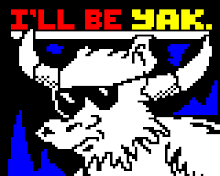
Maybe I could widen the research project to encompass different types of pixel graphics produced by other media - namely early 8-bit computer games and the early Internet. By also bringing in aspects of the written/printed media I could draw up similarities and contrasts between the different methods of production.

Looking at some of the stuff by Jodi has inspired me to think of areas such as ASCII art, which has not been a widely used medium in teletext but is the same principle of using a basic character set.
This article talks about the quest to code a font that reproduces the teletext font on the PC format. It seems the Minitel ASCII and the one used on computers are different despite containing, on the whole, much the same characters. The image to the left shows an Atom VDG (chip for early 1980s computers) character set. Note the strange pixel characters: these are similar to the ones used in Teletext to create images.
Some possible areas for explorationTake the three mediums and explore the following criteria.
> Use of
language. Visual and textual.
> Use of
interaction. Methods of interaction - special devices. Remote controls, joypads, pucks etc.
>
Format of medium itself. Teletext - televisions - compatibility. Device people are familiar with. Also don't have to purchase a new system
>
Purpose and target audience. Reaching different parts of the world, individual services for regional areas. Different reasons in different areas but largely based on information provided by the TV channel.
>
Longevity and popularity. Are they still around today?
> Medium as an
information service
The main thing, it seems, is that the Internet has largely overtaken the purpose of teletext and, due to its advances in technology, has widened its scope. However Teletext remains much the same. Whilst the 'new age' of digital set top boxes has brought reduced loading times, the abundance of the net and its now relatively inexpensive access has contributed to teletext's reduction in popularity.
The original service as we know it will be phased out in the next few years in the UK with the switch to digital (digital teletext page from Teletext Ltd. screenshot shown right). In fact, teletext, along with early video games, has gained popularity from the Internet's spreading of these via emulation. Maybe this could be my closing statement.
 A 'text artist', Holzer uses the structures of mass media to "smuggle messages into the public arena". Taking the form of pointed one liners projected onto such public spaces as the large screen in Times Square, New York, her work, according to the artist herself, revolves around 'Sex, death and war'.
A 'text artist', Holzer uses the structures of mass media to "smuggle messages into the public arena". Taking the form of pointed one liners projected onto such public spaces as the large screen in Times Square, New York, her work, according to the artist herself, revolves around 'Sex, death and war'.























 After a bit more digging, found a piece of software similar to the project I mentioned earlier in the post. After a little fiddling, I can't really work it very well - it takes some getting used to. I presume this is very similar to the stuff they actually use to program teletext to be broadcast on TVs. It isn't very user-friendly, however: takes a while to get the hang of things, as may be evident from the screenshot above displaying my lack of progress with the thing.
After a bit more digging, found a piece of software similar to the project I mentioned earlier in the post. After a little fiddling, I can't really work it very well - it takes some getting used to. I presume this is very similar to the stuff they actually use to program teletext to be broadcast on TVs. It isn't very user-friendly, however: takes a while to get the hang of things, as may be evident from the screenshot above displaying my lack of progress with the thing.











